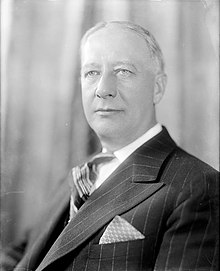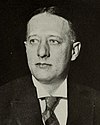
Back آل سميث Arabic ال اسمیت AZB Al Smith Catalan Al Smith Czech Alfred E. Smith German Al Smith Esperanto Al Smith Spanish ال اسمیت Persian Al Smith Finnish Al Smith French
Al Smith | |
|---|---|
 Smith c. 1920s | |
| 42nd Governor of New York | |
| In office January 1, 1923 – December 31, 1928 | |
| Lieutenant | George R. Lunn Seymour Lowman Edwin Corning |
| Preceded by | Nathan L. Miller |
| Succeeded by | Franklin D. Roosevelt |
| In office January 1, 1919 – December 31, 1920 | |
| Lieutenant | Harry C. Walker |
| Preceded by | Charles S. Whitman |
| Succeeded by | Nathan L. Miller |
| 8th President of the New York City Board of Aldermen | |
| In office January 1, 1917 – December 31, 1918 | |
| Preceded by | Frank L. Dowling |
| Succeeded by | Robert L. Moran |
| Sheriff of New York County | |
| In office January 1, 1916 – December 31, 1916 | |
| Preceded by | Max Samuel Grifenhagen |
| Succeeded by | David H. Knott |
| Member of the New York State Assembly from New York County's 2nd district | |
| In office January 1, 1904 – December 31, 1915 | |
| Preceded by | Joseph Bourke |
| Succeeded by | Peter J. Hamill |
| Personal details | |
| Born | Alfred Emanuel Smith December 30, 1873 New York City, U.S. |
| Died | October 4, 1944 (aged 70) New York City, U.S. |
| Resting place | Calvary Cemetery |
| Political party | Democratic |
| Spouse |
Catherine Dunn
(m. 1900; died 1944) |
| Children | 5 |
| ||
|---|---|---|
|
Governor of New York Other campaigns for president:
Member of the |
||
Alfred Emanuel Smith (December 30, 1873 – October 4, 1944) was the 42nd governor of New York, serving from 1919 to 1920 and again from 1923 to 1928. He was the Democratic Party's presidential nominee in the 1928 presidential election, losing to Herbert Hoover of the Republican Party in a landslide.
The son of an Irish-American mother and a Civil War–veteran Italian-American father, true surname Ferraro, Smith was raised on the Lower East Side of Manhattan near the Brooklyn Bridge. He resided in that neighborhood for his entire life. Although Smith remained personally untarnished by corruption, he—like many other New York Democrats—was linked to the notorious Tammany Hall political machine that controlled New York City politics during his era.[1] Smith served in the New York State Assembly from 1904 to 1915 and held the position of Speaker of the Assembly in 1913. Smith also served as sheriff of New York County from 1916 to 1917. He was first elected governor of New York in 1918, lost his 1920 bid for re-election, and was elected governor again in 1922, 1924, and 1926. Smith was the foremost urban leader of the efficiency movement in the United States and was noted for achieving a wide range of reforms as the New York governor in the 1920s.
Smith was the first Roman Catholic to be nominated for president of the United States by a major party. His 1928 presidential candidacy mobilized both Catholic and anti-Catholic voters.[2] Many Protestants (including German Lutherans and Southern Baptists) feared his candidacy, believing that the Pope in Rome would dictate his policies. Smith was also a committed "wet" (i.e., an opponent of Prohibition); as New York governor, he had repealed the state's prohibition law. As a "wet", Smith attracted voters who wanted beer, wine, and liquor and did not like dealing with criminal bootleggers, along with voters who were outraged that new criminal gangs had taken over the streets in most large and medium-sized cities.[3] Incumbent Republican Secretary of Commerce Herbert Hoover was aided by national prosperity, the absence of American involvement in war, and anti-Catholic bigotry, and he defeated Smith in a landslide in 1928.
Smith then entered business in New York City, and became involved in the construction and promotion of the Empire State Building. He sought the 1932 Democratic presidential nomination but was defeated by Franklin D. Roosevelt, his former ally and successor as governor of New York. During the Roosevelt presidency, Smith became an increasingly vocal opponent of Roosevelt's New Deal.
